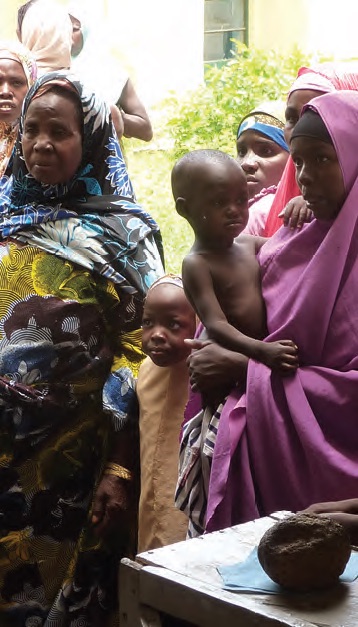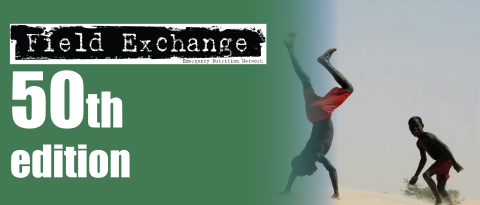The relationship between wasting and stunting: policy, programming and research implications
Summary of review1
This summary was prepared by Tanya Khara, an independent consultant engaged by the ENN on this review. The review was made possible by the generous support of the American people through the United States Agency for International Development (USAID).

Background
In 2014, ENN published a technical briefing paper ‘the relationship between wasting and stunting: policy, programming and research implications’. The paper is a narrative review of available literature on the relationship between wasting and stunting, conducted in consultation with a specifically formed technical interest group (TIG) of key experts in child growth and nutrition. The review was triggered by previous ENN work illustrating the divide in financing between wasting and stunting2 and a concern that this divide may have negative implications for children and nutrition targets. The wasting-stunting review aimed also to fill a gap identified by the American Society for Nutrition in 2012: “Little is known about how children progress from one manifestation of undernutrition to another as they grow older, nor how intervention strategies need to consider the potential overlap of these manifestations of undernutrition3
Methods
Journal articles found via PUBMED searches and reference lists, and resources contributed by TIG members were reviewed. Evidence of causes and effects, geographical and seasonal patterns, physiological mechanisms, and for direct relationships was included.
Findings
Burden
- Wasting and stunting occur together in many country contexts and may coexist in the same child, though the extent to which this happens is largely unreported. Being concurrently wasted and stunted may have particular causal pathways and effects which are not yet fully understood.
- Seasonality has a marked impact on both wasting and stunting prevalence. Rates of gain in weight and height often take place at different times of year and seem to be related over time in a consistent way, with height faltering peaking 2-3 months after weight loss/ wasting levels have peaked.
Shared risk factors
- Wasting and stunting share mainly common risk factors (dietary inadequacy, infectious disease in childhood, diarrhoea, maternal stature). Only Environmental Enteric Dysfunction and zinc inadequacy were identified in the literature as risk factors only for stunting.
- There is good evidence that in-utero conditions and foetal growth contribute significantly to stunting at birth and during infancy; and there is emerging evidence of contributions to wasting.
Shared effects
- Both wasting and stunting are associated with increased mortality. Where they coexist in the individual child there is evidence to suggest that the risk multiplies to a similar risk as the severely wasted child.
- Low muscle mass in both wasting and stunting and the link between muscle mass and survival during infection, suggest the risk of death associated with both conditions may be mediated through decreased muscle mass. However studies measuring body composition during both conditions are required to further investigate this hypothesis.
- Stunting is associated with child mental (cognitive) and psychomotor development. Evidence for wasting being associated with mental (cognitive) and psychomotor development is less strong.
Direct relationships
- Evidence suggests that linear growth slows at some point during wasting and that episodes of wasting in the previous three months (approximately) have an impact on attained length-for-age. Therefore, early identification and treatment of wasting may play a role in preventing stunting in particular contexts.
- Evidence that wasting treatment promotes linear growth of individual children is mixed. There are indications that optimising ready to use therapeutic food (RUTF) to include specific nutrients required for linear growth and development could have positive effects. However, preventing stunting relies on a range of nutrition specific interventions and nutrition sensitive approaches.
Programmatic approaches
- There is some encouraging operational research suggesting that both wasting and stunting (to a lesser extent) may be reduced with similar preventative food based approaches.
Implications and actions
The review elaborates implications of these findings and recommends a number of key actions:
1. Longitudinal data tracking nutritional status.
A number of limitations to available data were found during the review. Most importantly, measuring the association between wasting and stunting is challenged by the common use of cross sectional prevalence data. This does not allow for the capture of incident wasting cases occurring over time, nor how the causal pathways for wasting and stunting develop over time separately and in combination. Collection and analysis of longitudinal data tracking children’s status over time is required to better inform the design of services aiming to intervene in these causal pathways.
2. Concurrent wasting and stunting
We do not know the burden of concurrent wasting and stunting, the full implications for a child experiencing both deficits, nor whether these children are being already reached by services. Data is available that could be analysed as a priority to quantify national, regional and global burdens of concurrent wasting and stunting. Further research/analysis of mortality and morbidity implications of concurrent wasting and stunting is also required. At the same time the extent to which these children are being reached by current nutrition programmes needs to be investigated (particularly those using mid upper arm circumference (MUAC) and weight for age (WFA)).
3. Common prevention approaches and research
As wasting and stunting share mainly common risk factors the literature does not support a need for different preventive intervention packages. Common prevention approaches are required and policies which separate the two re-examined. In addition research could more routinely measure impacts on incidence of both forms of undernutrition in order to more appropriately inform programming for both conditions.
As wasting can adversely affect linear growth the timely identification and treatment of wasting may be an important component of stunting prevention in some contexts. The question of whether protocols for the treatment of wasting could also be optimised (i.e. through reformulation of RUTF) to promote linear growth requires further investigation, however.
4. Maternal nutrition
Evidence included in the review that both wasting and stunting have origins in foetal growth highlights the importance of attention to maternal and adolescent girl health and nutrition as part of wasting and stunting prevention approaches. It also suggests that further investigation is required to differentiate ponderal and linear growth in utero and at birth.
5. Seasonal approaches
The evidence of seasonal and related patterns in wasting and stunting does not infer causality as other seasonal factors may be involved. Further research is needed to better understand these seasonal relationships and to build on existing experience of what works to mitigate seasonal peaks in both deficits.
For more information, email: Tanya Khara
Footnotes
1Khara, T., & Dolan, C. (2014). Technical Briefing Paper: The Relationship between Wasting and Stunting, policy, programming and research implications. Emergency Nutrition Network (ENN) June 2014. http://www.ennonline.net/ourwork/reviews/wastingstunting
2Shoham J, Dolan C, Gostelow L, ENN (2013). The Management of Acute Malnutrition at Scale: A Review of Donor and Government Financing Arrangements. Main Report. March 2013. http://www.ennonline.net/enncmamfinancingreport2013
3Menon, P. and R. J. Stoltzfus (2012). Building convergence in science, programmes, and policy actions on child undernutrition: symposium rationale and overview. Adv Nutr 3(2): 224-226.


